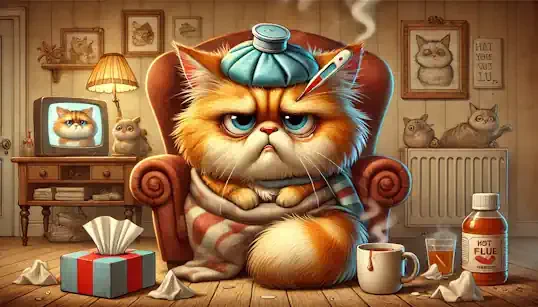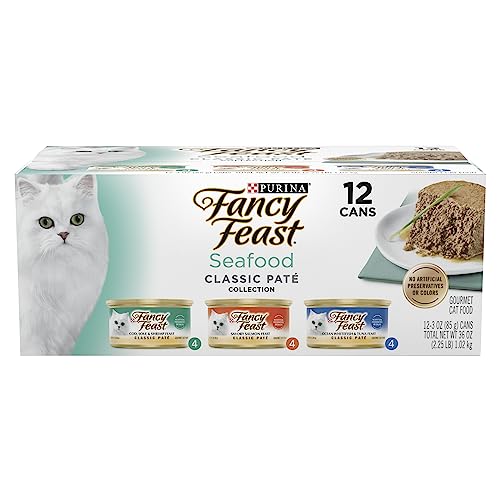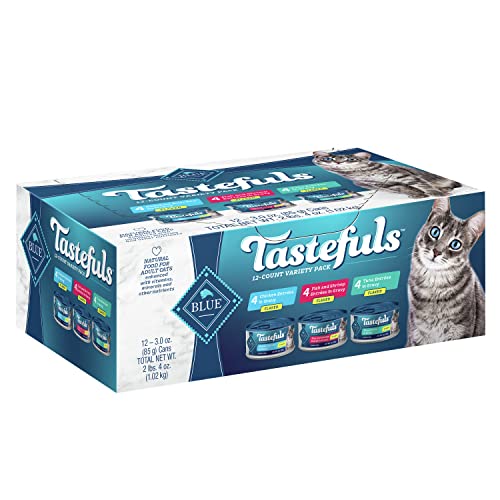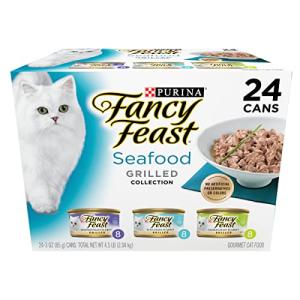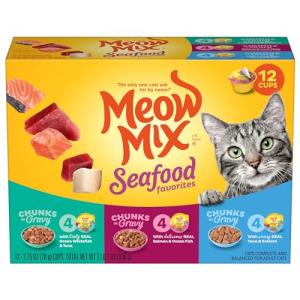You wake up to a tiny sneeze. Ah-choo! You glance over at your cat, curled up in their favorite sunbeam, and think, “Aww, bless you.” But then comes another sneeze. And another. Followed by a sniffle, maybe a little cough. Oh no. Could it be… the flu? Immediately, a wave of concern washes over you. Nobody wants to see their feline friend feeling under the weather, especially when it involves those dreaded flu-like symptoms. It’s natural to feel worried, maybe even a little panicked. We love our cats like family, and seeing them sick is always distressing.
But before you descend into full-blown worry, take a deep, calming breath. It's important to understand that while we often use the term "cat flu," what your cat is likely experiencing is not the human influenza virus. In fact, feline upper respiratory infections, often called "cat flu" for short, are entirely different from human flu and, crucially, cannot be transmitted from cats to humans. So, you can breathe a sigh of relief knowing you won't catch anything from your sneezing companion. The term "cat flu" is really just a common, if slightly misleading, way of describing Feline Upper Respiratory Infections, or FURIs. Think of it like a cat cold, or a nasty head cold in humans. While definitely unpleasant for your kitty, and certainly warranting your attention and care, feline URIs are generally manageable, and most cats recover fully with appropriate home care and, when needed, veterinary treatment. So, let's shift our focus from worry to action. This article is your guide, your reassuring companion, as you navigate your cat’s sniffles and sneezes. We'll demystify these feline URIs, help you recognize the symptoms, provide step-by-step advice on how to make your cat comfortable at home, guide you in knowing when it's time to seek professional veterinary help, and equip you with preventative strategies to keep those sniffles at bay in the future. Together, we’ll get your feline friend back to their purrfect selves in no time.
To understand how to best care for your cat, let's first understand what exactly we’re dealing with when we talk about “cat flu” or feline upper respiratory infections. At their core, feline URIs are infections that affect the upper respiratory system in cats, which includes their nose, throat, and sinuses. Think of it like a human getting a cold or the flu, but specifically affecting the feline upper respiratory tract. And just like human colds and flu, the most common culprits behind these infections are viruses. There are two main viral villains that are most frequently responsible for feline URIs: Feline Herpesvirus (FHV-1) and Feline Calicivirus (FCV). Feline Herpesvirus, or FHV-1, is a very common virus in the cat population. Once a cat is infected with FHV-1, it often becomes a lifelong carrier. This doesn't mean they are constantly sick, but the virus can lie dormant in their bodies and reactivate, causing flare-ups of URI symptoms, especially during times of stress or when their immune system is weakened. Think of it like human herpes simplex virus, which causes cold sores – once you have it, it can periodically reactivate. Feline Calicivirus, or FCV, is the other major viral player in feline URIs. FCV infections often present with slightly different symptoms compared to FHV-1. While both can cause sneezing and nasal discharge, FCV is more frequently associated with the development of painful mouth ulcers, which can make eating and drinking uncomfortable for affected cats.
While viruses are the primary cause of most feline URIs, bacteria can also sometimes be involved, often as secondary infections. These bacterial infections typically occur after a viral infection has already weakened the cat’s immune system and made them more susceptible to bacterial invaders. Common bacterial culprits include Bordetella bronchiseptica and Chlamydia felis. These bacteria can exacerbate the symptoms of a viral URI or sometimes cause URIs on their own. So, how do cats actually catch these pesky URIs? Unfortunately, feline URIs are highly contagious among cats. Transmission primarily occurs through direct contact with sick cats. This can happen through close contact behaviors like sneezing, coughing, or grooming each other. The viruses and bacteria are spread through respiratory droplets expelled when an infected cat sneezes or coughs. Sharing food and water bowls, or even litter boxes, can also contribute to the spread of URIs, as these items can become contaminated with infectious agents. And, as mentioned, those airborne droplets from sneezing and coughing can travel a short distance, spreading the infection through the air in close proximity. It’s important to remember that stress plays a significant role in feline URIs. Stress can weaken a cat's immune system, making them more vulnerable to catching infections in the first place. Stress can also trigger flare-ups of latent viruses like FHV-1 in cats who are already carriers. Understanding that "cat flu" is usually a contagious URI, often viral in origin, and spread through close contact and environmental contamination, is key to managing the situation effectively and implementing preventative measures, especially in multi-cat households or environments where cats may come into contact with other felines.
Recognizing the symptoms of "cat flu" early is crucial so you can start providing supportive care and determine when veterinary intervention is needed. The most obvious signs of a feline URI are respiratory in nature, mirroring human cold symptoms. Sneezing and coughing are often the first and most noticeable indicators. You might hear your cat sneezing more frequently, or develop a cough that sounds raspy or wet. Runny nose, or nasal discharge, is another classic symptom. The discharge can range in consistency from clear and watery initially to becoming thicker and more colored (yellow or green) as the infection progresses, particularly if a secondary bacterial infection develops. Congestion and sniffling are also common, as the nasal passages become inflamed and filled with mucus. You might hear your cat sniffling, snorting, or breathing noisily due to nasal congestion. Watery eyes, or ocular discharge, often accompanies nasal discharge. Similar to nasal discharge, eye discharge can start clear and watery, and become thicker or colored over time.
Beyond respiratory signs, other symptoms often accompany feline URIs. Lethargy and fatigue are common. Your usually active cat might become unusually sleepy, less playful, and generally less energetic. Loss of appetite, or a reduced appetite, is another frequent symptom. A stuffy nose can diminish their sense of smell, which plays a significant role in appetite, and mouth ulcers (especially with calicivirus) can make eating painful. Fever, or an elevated body temperature, can also occur, although it's often subtle in cats and not always easy to detect at home without a thermometer. Mouth ulcers are a particularly tell-tale sign of Calicivirus infection. Look for sores or ulcers on the tongue, gums, or palate. These ulcers can be painful and cause drooling and a marked reluctance to eat, as eating becomes uncomfortable. Sometimes, a voice change, such as a hoarse meow, can occur due to inflammation of the larynx (voice box) as part of the URI. It's important to remember that the severity of symptoms can vary greatly between cats. Some cats might only experience mild sniffles and sneezing, while others can become quite ill with more pronounced symptoms like severe lethargy, loss of appetite, and difficulty breathing. Being aware of this range of symptoms allows you to recognize "cat flu" early, assess the severity of your cat's illness, and begin providing appropriate home comfort care, while also knowing when those "red flag" symptoms signal the need for prompt veterinary attention.
When your cat starts showing signs of a URI, your first instinct is often to nurture them back to health at home. And in many mild cases of "cat flu," supportive home care can make a significant difference in your cat’s comfort and recovery. Creating a healing haven for your sick kitty starts with providing a warm and restful environment. Offer them a quiet and comfortable resting place, away from household hustle and bustle. A cozy bed in a draft-free, warm area is ideal. Consider providing extra blankets to snuggle in, or even a pet-safe heated bed (if supervised to prevent overheating), to help them stay warm, especially if they have a fever or are feeling lethargic and chilled.
Encouraging appetite is crucial, as sick cats often lose interest in food, but nutrition is vital for recovery. Offer highly palatable wet food. Wet food is generally more enticing to sick cats due to its stronger aroma, and it's also easier to swallow if they have a sore throat or mouth ulcers. Warm the food slightly. Warming wet food to slightly above room temperature can enhance its aroma, making it even more appealing to a cat with a diminished sense of smell due to congestion. Try offering especially smelly foods that are typically irresistible to cats, such as tuna, salmon, or even small amounts of plain meat baby food (always check labels to ensure it contains no onion or garlic, which are toxic to cats). Use these tempting options cautiously and in moderation, as they are not nutritionally balanced for long-term feeding. If your cat is refusing to eat altogether, and only with veterinary guidance, you might consider assisted feeding, such as hand-feeding very small amounts of food or, in more severe cases, syringe feeding a liquid diet, but always consult your veterinarian before attempting syringe feeding, as it needs to be done correctly to avoid aspiration. Staying hydrated is just as important as nutrition. Ensure fresh water is always readily available, placing multiple water bowls around the house, easily accessible to your resting cat. Offer broth or flavored water, such as low-sodium chicken or fish broth (again, ensure no onion or garlic!), to entice them to drink more. The moisture content of wet food also contributes significantly to their overall hydration. It’s crucial to monitor for signs of dehydration. Check their gums – they should be moist, not dry or tacky. Their saliva should be watery, not sticky. You can also gently perform a skin tent test by pinching a small fold of skin on their back; it should spring back quickly when released, not tent slowly. If you notice signs of dehydration, it’s a red flag and a reason to contact your veterinarian promptly.
To help soothe congestion and make breathing easier, gentle nasal and eye care is beneficial. Gently wipe away nasal discharge with a soft, damp cloth throughout the day to keep their nasal passages clear and facilitate easier breathing. Use a separate clean, warm, damp cloth to gently wipe away eye discharge. Warm compresses can help soften any crusts around the eyes before gently wiping them away. Steam therapy can also be incredibly soothing for congested nasal passages. A safe and gentle way to do this is to take your cat into the bathroom while you take a warm shower (but not directly in the shower!). The steam can help loosen congestion. Alternatively, use a humidifier in the room where your cat is resting to increase the humidity of the air. Avoid forcing your cat into enclosed, steamy spaces if they are stressed by it; the goal is to provide gentle, comforting steam, not to cause further anxiety. Finally, maintaining good hygiene is important to support your cat’s recovery and minimize the spread of germs. Keep their litter box scrupulously clean and easily accessible, even if they are feeling unwell, to encourage continued use. Gentle grooming, if your cat tolerates it while sick, can help them feel more comfortable and remove any matted fur or discharge, but avoid stressing a sick cat with prolonged grooming sessions. Wash your cat’s food and water bowls regularly to help minimize the spread of germs and bacteria. These home comfort care measures, when implemented consistently and with gentle patience, can go a long way in supporting your cat through a mild case of "cat flu" and helping them feel as comfortable as possible while their body recovers.
While home care is beneficial for mild cases, it’s crucial to recognize when "cat flu" symptoms warrant veterinary attention. There are certain "red flag" symptoms that should prompt you to seek professional veterinary help promptly. Severe lethargy or weakness is a concerning sign. If your cat is unusually unresponsive, very weak, or seems close to collapsing, it’s an emergency. Complete loss of appetite for more than 24 hours is also a red flag, especially in cats who are overweight, as they are at risk of developing hepatic lipidosis, a serious liver condition, if they stop eating. Signs of dehydration, as discussed earlier, also indicate the need for veterinary intervention to provide fluid support. Difficulty breathing, rapid breathing, or wheezing are clear signs of respiratory distress and require immediate veterinary attention to assess lung function and oxygen levels. If coughing persists or worsens, it could indicate pneumonia or other more serious lower respiratory tract complications that need veterinary treatment. A high fever, if you are able to safely take your cat’s temperature at home (rectally, using a pet thermometer and lubricant – consult your vet for proper technique), or a fever that persists for more than a day, suggests a more significant infection that may require veterinary management. Thick, colored nasal or eye discharge – particularly if it's yellow or green – often indicates a secondary bacterial infection has developed, which usually requires antibiotic treatment from your veterinarian. Mouth ulcers, especially if they are severe, causing excessive drooling, or preventing your cat from eating due to mouth pain, need veterinary attention to diagnose the underlying cause (often Calicivirus) and provide pain relief and supportive care. Kittens, senior cats, and cats with any underlying health issues (like asthma, heart conditions, or kidney disease) are at higher risk of developing complications from URIs and should be seen by a veterinarian sooner rather than later, even if symptoms initially seem mild. Finally, and importantly, if your cat’s symptoms are not improving after a few days of consistent home care – typically within 2-3 days – it’s time to seek veterinary advice. And, perhaps most importantly, “trust your gut.” If you are seriously worried about your cat, or if something just "doesn't seem right" to you, it’s always best to err on the side of caution and consult your veterinarian. Your intuition as your cat’s owner is valuable and should not be dismissed.
When you bring your cat to the veterinarian for "cat flu" symptoms, they will first focus on confirming the diagnosis. The veterinarian will perform a thorough physical examination, assess your cat's symptoms, and take a detailed history of the onset and progression of the illness. In many straightforward cases of mild to moderate URI, further diagnostic tests may not be necessary, and the diagnosis can be made based on clinical signs alone. However, in more severe cases, or if the diagnosis is unclear, your veterinarian might recommend further diagnostic tests, such as nasal or eye swabs to identify specific viruses or bacteria, or bloodwork to assess overall health and rule out other underlying conditions. If your cat is dehydrated or severely ill, supportive care at the veterinary clinic may be necessary. This might include intravenous (IV) fluids to correct dehydration, and nutritional support, such as assisted feeding or placement of a feeding tube, if your cat is not eating adequately on their own. Antibiotics are often prescribed if a secondary bacterial infection is suspected, based on the type and color of nasal or eye discharge, or if your cat has a fever that persists. It’s important to remember that antibiotics are effective against bacteria, but they do not directly treat viral infections, which are the primary cause of most feline URIs. However, antibiotics can be crucial in treating secondary bacterial infections that can complicate viral URIs. In some specific cases, particularly for severe Herpesvirus infections, antiviral medications might be considered by your veterinarian, although they are not always routinely used for typical URIs. For cats with conjunctivitis (eye inflammation and discharge), your veterinarian may prescribe medicated eye drops or ointments. And for nasal congestion, they may recommend nasal decongestants, although these should only be used with explicit veterinary guidance, as some human decongestants are toxic to cats. If your cat is experiencing mouth ulcers or is showing signs of pain or discomfort, your veterinarian may prescribe pain relief medication to improve their comfort and encourage eating. In very severe cases of URI, particularly if a cat develops complications like pneumonia or severe dehydration, hospitalization for intensive care and monitoring may be necessary.
Prevention, as always, is better than cure. And fortunately, there are effective strategies to help keep your cat sniffle-free and minimize the risk of "cat flu." Vaccination is absolutely key in preventing feline URIs, particularly those caused by the most common viral culprits, FHV-1 and FCV. The core FVRCP vaccine (Feline Viral Rhinotracheitis, Calicivirus, and Panleukopenia) provides significant protection against severe illness caused by these viruses. Ensure your cat receives their core FVRCP vaccines according to your veterinarian's recommended schedule, including kitten vaccination series and booster vaccinations throughout their adult life. Good hygiene practices are also essential, especially in multi-cat households or shelters. Maintain a clean environment by regularly cleaning and disinfecting cat living areas, food and water bowls, and litter boxes. In multi-cat homes, consider separating food and water bowls and litter boxes to reduce the sharing of potential germs. Always wash your hands thoroughly after handling cats, especially if one cat in the household is showing signs of illness. Stress reduction is a crucial but often overlooked aspect of preventing feline URIs. Minimize stress in your cat’s life as much as possible, as stress weakens the immune system and makes them more susceptible to infections and flare-ups. Maintain a stable daily routine, provide a safe and predictable environment, and minimize exposure to stressful situations. A strong immune system is the foundation of good health. Support your cat's immune system with good nutrition by feeding a high-quality, balanced cat food, ensuring they have access to fresh, clean water at all times, and promoting a healthy lifestyle with appropriate exercise and mental stimulation. And finally, when possible, minimize exposure to potentially sick cats, especially if your cat is unvaccinated or has a weakened immune system. For indoor cats, this is often easier to control. For outdoor cats, be aware of the risks of contact with unknown or potentially sick cats in the neighborhood, although completely limiting outdoor access isn't always feasible or desirable for all cats.
So, sniffles sorted! Remember, while "cat flu" can sound alarming, it’s usually a common and manageable condition, and the vast majority of cats recover fully, especially with prompt care and attention. You are now equipped with the knowledge and practical tools to provide excellent home comfort care for your sneezing feline friend, and to confidently recognize those “uh oh” moments when veterinary intervention becomes essential. Focus on providing loving comfort and attentive care; your nurturing presence is just as important as any medication in helping your cat recover. Implement those home care measures, monitor your cat closely for any red flag symptoms, and don't hesitate to contact your veterinarian if you have any concerns. With your loving care, your feline companion will be back to their purrfect, playful selves, filling your home with happy purrs and feline antics once again, leaving those sniffles and sneezes far behind.
